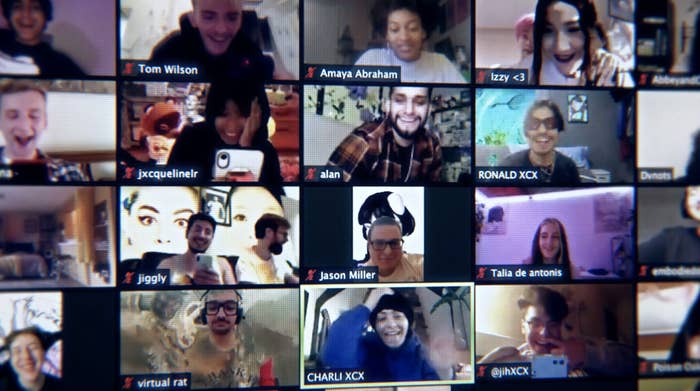
The world started shutting down in 2020, just as Charli XCX’s career was taking off to new heights.
She had been beloved by both the underground rave scene and Billboard's top charts for years, and her hit singles “Blame It on Your Love” and “1999” were racking up hundreds of millions of streams. She’d just concluded a tour across the US and Europe following the release of her third album, Charli, when stay-at-home orders suddenly ended all concerts. But the hyperpop singer had a plan.
“I’m going to make a brand-new album during this quarantine period,” she announced on April 6. “The album is going to be called How I’m Feeling Now, and I’m going to set the release date for May 15.”
Such is the premise of Alone Together, Charli XCX’s new documentary out in theaters Friday. The film follows Charli as she sprints through her album’s composition, production, and release, all within a span of five weeks. (Why five weeks? Once upon a time, people thought COVID would blow over in a month. Were we ever so young?) Alone Together is a visual document of the album’s creation and an unusually symbiotic relationship between artist and fandom in which fans help her create the record that she then sells back to them.
Though it’s set in a time I wish to never, ever return to, the documentary takes us inside Charli’s hyperfocused creative process. We see her scrawl down lyrics, record vocals, and writhe in a green screen bodysuit to shoot a music video. Cameras follow her around her LA home as she learns to live with Huck Kwong, her partner of seven years who’s apparently never cohabitated with her for longer than 11 days.

All the while, the threat of COVID looms outside. Fans come forward with stories of how the pandemic has left them jobless, isolated, or trapped in unsafe living environments. Charli tearfully confesses to implacable COVID anxiety and the pain of not seeing her loved ones. Over the course of the album’s five-week creation, states issued their first mask mandates, stay-at-home orders stretched from weeks into months, and the US reached over 1 million confirmed COVID cases.
"We wanted the most raw and unfiltered view into her life as it was in that moment,” Bradley Bell and Pablo Jones-Soler, the documentary’s directors and Charli’s longtime collaborators, told BuzzFeed News over email. In order to shoot during lockdown, the pair, known professionally as Bradley & Pablo, sent camera equipment to Charli’s home and relied on her and the other subjects to film themselves. “We wanted blood, sweat, and tears, but this is not something we had to fight for.”
At one point in the film, the singer opens up about starting therapy during the pandemic. “I’ve got serious issues with the way I handle my work and the way I depend on work to make me feel like I’m a good person,” Charli explained. As she says this, the screen unveils a tweet she posted that reads, “Sometimes I wake up and I fucking hate myself,” only to immediately cut away to a clip of her recording a song outro.
More than anything, Alone Together is an intimate portrait of Charli’s fan community, aka her Angels. As she records How I’m Feeling Now, Charli asks them for input on everything from her album art to song lyrics.
During one Instagram Live, she begins by saying, “I’m currently writing a new song, and I need your help on some lyrics and stuff.”
After playing a heavy synth beat and doing some quick a capella for listeners, Charli scans the comment section for lyric suggestions. “Someone said ‘going’… ’morphing’… ‘exhausting’ is good… OK, this is the verse. Thank you for helping me write it,” she said. The final lyric ends up as “These days exhausting” in her song “anthems.”

Altogether, the Angels contributed over 5,000 music video clips, 2,000 cover artworks, and 3,000 remixes. In exchange for glimpses of Charli’s creative process, fans joined livestreams and chat rooms and Zoom calls to weigh in on the very songs they’re waiting to be released, which in turn become part of a documentary that they can’t wait to watch.
Watching the film as a fan myself, I couldn’t shake the sense that I was also participating in a massive feedback loop between Charli, Charli’s fans, and Charli’s content production. Between the documentary, the album, the virtual benefit concert, and the onslaught of accompanying social media events — along with the press circuit and merch, which are customary for signed artists — fans’ contributions transformed a single album into something that borders on a franchise.
"It is typical to think of brands in relation to physical products or companies, but artists can also be thought of as brands and by extension as entities that attract loyalty,” James Obiegbu, a Bournemouth University researcher who studies the intersection of consumerism and the arts, said. “Commerce in the context of artistry does not have to be a dirty or unwelcome association.”
Alone Together makes the inherently commercial nature of relationships between artists and fans obvious. Fans give their energy, attention, and creativity to Charli, and these things help build her album and documentary for further consumption. But while some may balk at the idea of commodifying fan interest, is it always a problem? Angels don’t think so, as long as it feels like Charli prioritizes “authenticity.”
“A neat thing about being a fan of Charli XCX is that she goes above and beyond,” Grace Marr, a 23-year-old nonprofit employee and longtime Angel, told BuzzFeed News. “She’s deeply personal. Even away from her music, the way she shares on Instagram and TikTok, it feels more intimate than other artists.”
Brooklyn-based fan Karl Ortegon agreed, adding that the Angel community has been a haven for LGBTQ fans for years. “She’s a pop star who makes music for gays,” Ortegon, a 25-year-old working in social media, said. “She’s very heralded in queer nightlife spaces, and I feel like it’s because she reads as very authentic and accessible. People resonate with that.”
Contrast that to “other celebrities [who] were singing ‘Imagine’ covers or hunkering down in luxury bunkers until it all blew over,” directors Bell and Jones-Soler noted, stressing that Charli’s quarantine album and documentary were a public gamble.

“Opening up your creative process like that is an extremely daunting prospect,” they said. “What if everything fails? What if she couldn't write? She opened herself up to failing in public and I don't think very many musicians of her caliber would feel comfortable putting themselves in that situation."
In fact, it’s possible that Charli’s blatant reliance on fans in Alone Together is its own way of admitting vulnerability. She needed them to actually produce her own creative work. The transparency throughout How I’m Feeling Now not only produced a plethora of content but also changed her relationship with her own fans.
As I was watching Alone Together, it dawned on me that I didn’t know how to have a relationship with Charli — or any artist, for that matter — that wasn’t underpinned by consumption. But maybe that’s not important. “I don’t expect that artists owe their fans anything more than the music — and even that they’re not contractually obligated to give more of,” Ortegon said.
And Charli offering herself in the form of so many commercial products is a gift that still rings authentically for her Angels.
“If she did something that was less genuine, I don’t think it would have as much of an impact,” Marr said.
